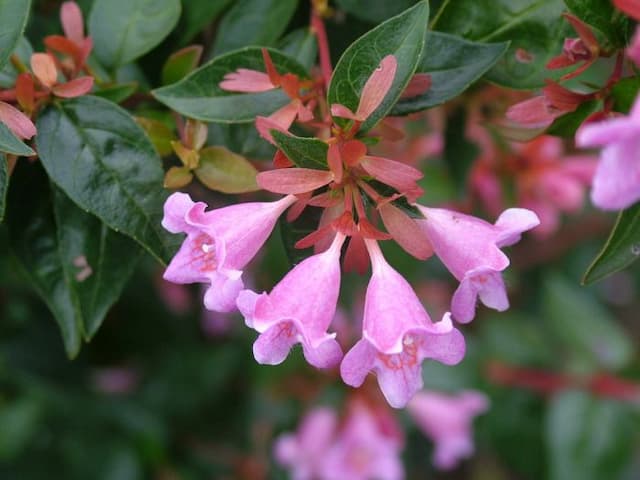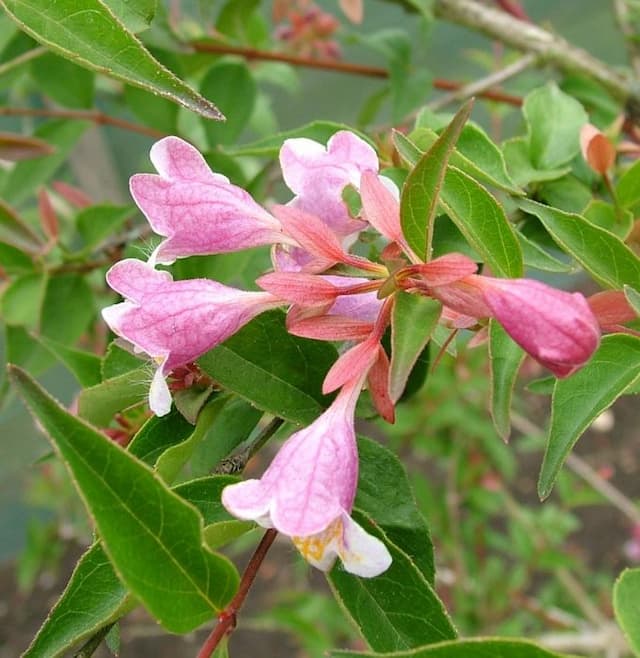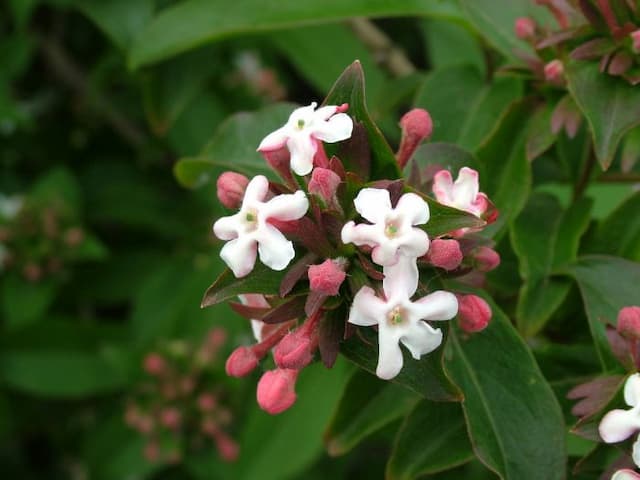Winter Honeysuckle Lonicera × purpusii 'Winter Beauty'

ABOUT
Winter Beauty is a deciduous or semi-evergreen shrub known for its striking winter flowers. This plant has a bushy habit with arching branches that bear opposite leaves. The foliage is typically oval in shape, coming to a point at the end, and can present a lush green background for its florals, often remaining throughout winter in milder climates. The most captivating feature of Winter Beauty is its fragrant flowers, which bloom during the colder months when few other plants flower. These blooms are creamy white and sometimes tinged with yellow, appearing in pairs along the branches. They have a tubular shape, flaring out to a lip-like form at the opening, and can stand out splendidly against the plant's dark green leaves. After the blossoming period, which often peaks in late winter, berries may follow; they are typically red or orange berries that can attract birds and other wildlife to the garden. The overall appearance of Winter Beauty is that of a lush, flowering shrub that adds color and fragrance to the winter landscape.
About this plant
 Names
NamesFamily
Caprifoliaceae.
Synonyms
Winter Honeysuckle, Winter Beauty.
Common names
Lonicera × purpusii 'Winter Beauty'
 Toxicity
ToxicityTo humans
Winter Honeysuckle is not commonly regarded as a toxic plant to humans, and there are no widespread reports of poisoning. However, as with any plant, individual allergies or sensitivities may occur, and it is generally advisable not to ingest parts of ornamental plants due to potential adverse reactions.
To pets
Winter Honeysuckle is not commonly listed as toxic to pets, such as dogs and cats. However, pets might experience digestive upset if they consume large quantities of the plant. It's always best to monitor your pets around plants and prevent them from ingesting any plant material to avoid potential issues.
 Characteristics
CharacteristicsLife cycle
Perennials
Foliage type
Deciduous
Color of leaves
Green
Flower color
Cream
Height
6 feet (1.8 meters)
Spread
8 feet (2.4 meters)
Plant type
Shrub
Hardiness zones
4
Native area
Cultivar
Benefits
 General Benefits
General Benefits- Attractive Winter Blooms - Adds color to the garden during the dull winter months.
- Fragrant Flowers - Offers a sweet fragrance that enhances the sensory appeal of a garden or landscape.
- Attracts Wildlife - Provides nectar for bees and other pollinators, which are active on mild winter days.
- Low Maintenance - Generally easy to care for, requiring minimal pruning and upkeep.
- Hardy - Capable of withstanding cold winter temperatures, making it suitable for a variety of climates.
- Versatile Landscaping - Can be used in borders, mixed beds, or as a standalone specimen.
- Fast-Growing - Quick to establish and can reach full size in a relatively short period, creating an impact in the garden swiftly.
- Long Blooming Period - Often flowers from late winter into early spring, providing a long period of visual interest.
 Medical Properties
Medical PropertiesThis plant is not used for medical purposes.
 Air-purifying Qualities
Air-purifying QualitiesThis plant is not specifically known for air purifying qualities.
 Other Uses
Other Uses- Crafting Natural Dyes: The Winter Beauty honeysuckle can be used to create natural dyes for fabrics due to the pigments in its leaves and flowers.
- Wildlife Gardening: Planting Winter Beauty honeysuckle can attract a variety of wildlife to your garden, such as birds and beneficial insects, aiding in biodiversity.
- Floral Arrangements: The fragrant flowers of Winter Beauty honeysuckle can be used to add fragrance and aesthetic appeal to floral arrangements.
- Photography Attraction: This plant can serve as an excellent subject for photographers, particularly when looking to capture winter landscapes with flowering plants.
- Garden Design: Winter Beauty honeysuckle can be incorporated into garden designs to create focal points or to soften hard landscapes during the winter months.
- Educational Tool: Use the plant in educational settings to teach about pollination, as it continues to flower in winter when fewer plants are in bloom.
- Culinary Garnishes: The flowers, being edible, can be used as garnishes to add a touch of elegance to culinary dishes.
- Backyard Habitat Creation: Its dense growth provides shelter and nesting sites for small birds during the harsher winter months.
- Scented Potpourri: Dried flowers of Winter Beauty honeysuckle can be included in potpourri mixtures for their pleasant fragrance.
- Art Inspiration: Artists can use the unique appearance and structure of the Winter Beauty honeysuckle as inspiration for botanical illustrations or other art forms.
Interesting Facts
 Feng Shui
Feng ShuiThe plant Winter Honeysuckle is not used in Feng Shui practice.
 Zodiac Sign Compitability
Zodiac Sign CompitabilityThe plant Winter Honeysuckle is not used in astrology practice.
 Plant Symbolism
Plant Symbolism- Devotion: The Lonicera, commonly known as honeysuckle, is often associated with loving affection and devotion due to the entwining nature of its vines, symbolizing the close-knit bond between people.
- Happiness: Honeysuckle flowers bring sweetness and joy with their pleasant fragrance, which is believed to improve moods and invite delight.
- Generosity: The abundant and generous blooming of honeysuckle suggests a spirit of giving and kindness, as the plant often provides ample flowers and fragrance.
- Nostalgia: The scent of honeysuckle can evoke fond memories of the past and the warm feeling of nostalgia, representing connectivity to one's roots and heritage.
- Protection: Traditionally, honeysuckles were planted near homes to ward off evil spirits, and its symbolism extends to offering protection and safekeeping.
 Water
WaterWinter Honeysuckle should be watered deeply to ensure the soil is moist but not waterlogged, requiring about 1 gallon of water per week during its growing season. Watering frequency should be adjusted based on weather conditions with less water needed during rainy periods and more during dry spells. During the winter, reduce watering but do not allow the soil to completely dry out. Ensure that the water reaches the root zone by applying it directly at the base of the plant.
 Light
LightWinter Honeysuckle thrives in partial to full sun exposure. Ideally, it should be placed in a spot where it can receive at least four to six hours of sunlight a day. Some dappled shade during the hottest part of the afternoon can help prevent leaf scorch, especially in areas with intense summer sun.
 Temperature
TemperatureWinter Honeysuckle is hardy and can withstand temperatures as low as -20 degrees Fahrenheit, making it suitable for a range of climates. The ideal growing temperatures are between 60 and 80 degrees Fahrenheit. Extreme heat over 90 degrees Fahrenheit could be detrimental to the plant, so provide some shade or water more frequently during hot spells.
 Pruning
PruningWinter Honeysuckle should be pruned after flowering to maintain shape and encourage new growth. Prune out any dead or damaged branches and thin the plant to improve air circulation. Pruning can be done annually, but heavy pruning should be done only every few years to allow the plant to recover and bloom effectively.
 Cleaning
CleaningAs needed
 Soil
SoilWinter Honeysuckle prefers well-draining soil rich in organic matter with a pH between 6.0 and 7.5. A mix of loam, peat, and coarse sand in equal parts works well to maintain the right balance of moisture and aeration.
 Repotting
RepottingWinter Honeysuckle, being a shrub, does not typically require repotting if planted in the ground. In containers, repot every 2-3 years to refresh the soil and provide room for growth.
 Humidity & Misting
Humidity & MistingWinter Honeysuckle thrives in average outdoor humidity levels; it does not have specific humidity requirements and is quite adaptable to varying conditions.
 Suitable locations
Suitable locationsIndoor
Grow in bright light, water when dry, and provide support for vines.
Outdoor
Plant in well-draining soil, full sun to part shade, and water regularly.
Hardiness zone
4-9 USDA
 Life cycle
Life cycleLonicera × purpusii 'Winter Beauty', commonly known as Winter Beauty Honeysuckle, begins its life cycle when its seeds germinate in spring, provided they're sown in well-draining soil and with adequate warmth. Seedlings develop into young plants, which focus their energy on establishing a robust root system and producing foliage. As the plant matures, typically after a few years, it enters the flowering stage, with Winter Beauty Honeysuckle blooming in late winter to early spring, showcasing fragrant cream-colored flowers. After pollination, which is often carried out by insects attracted to its scent, the plant produces small red to black berries. These berries are sources of seed dispersal, often carried away by birds, allowing the cycle to begin anew. The plant eventually reaches senescence, where growth slows and it may die back, though it can live for many years with proper care and can also propagate vegetatively through cuttings.
 Propogation
PropogationPropogation time
Late Winter to Early Spring
The Lonicera × purpusii 'Winter Beauty', more commonly known as the Winter Honeysuckle, is typically propagated through semi-hardwood cuttings. This process is usually done in late summer. To propagate using this method, a gardener would select a healthy, non-flowering shoot and cut a piece that is about 4 to 6 inches long. The bottom leaves of the cutting should be removed and the cut end can be dipped in a rooting hormone to encourage root development. The cutting should then be planted in a mixture of peat and perlite or sand to provide good drainage and keep it moist. Keeping the cutting in a warm place with indirect light will help roots to develop. After a few weeks, when roots have established, the new plant can be transplanted into a larger pot or directly into the garden.







![Himalayan honeysuckle [Golden Lanterns]](/_next/image?url=https%3A%2F%2Fplants-admin.emdemapps.com%2Fimages%2Fplants%2F%2Fimages%2F604b55302cc87.png&w=640&q=75)

